Ray Hahn
Postcards
and the Power of Suggestion
Last Thursday at noon, I stepped away from my desk to check the thermometer in my backyard. The meter is shaded by a very old pin-oak tree, but it still registered 101°. The following day, I left home early in the morning for a 305-mile drive to Harrisonburg, Virginia. I have made this trip every July (except two) since the early 1990s and my destination is the Shenandoah Valley Postcard Show hosted by Jeff Bradfield.
It is now one week later and just after nine o’clock. We arrived home after a delightful couple days at the postcard show, a visit with family in Fredericksburg, and a delightful dinner at a family-favored restaurant.
With such good memories, it is a perfect time to share with Postcard History’s readers a set of postcards, purchased at the Shenandoah event. The temperature tonight is 83° and the thought went through my head that writing about a set of Tuck postcards with a winter theme may well be a suggestive element to “think cool!”

The power of suggestion is not physical; no energy – solar, mechanical, or chemical is involved. The power of suggestion is merely an idea held by one individual that when passed on to another becomes a truth that is real and genuine. In all, it is pure psychology and is how psychologists help their patients change their behavior.
Whatever science there is behind the power of suggestion is in the response expectations. Here’s how: if a person presents an allusion to another and suggests that a special kind of response will occur, the person is likely to behave in that very same way. More frequently, than not, the person to whom a suggestion is being made wants to please, and his behavior will automatically adjust to bring about that suggested response. This is the power of suggestion.
Good examples of how suggestibility influences an individual are found among participants in athletic events that feature single performance athletes, as opposed to teams. When someone is faced with the inevitable truth that failure is possible, it is the psychiatric element of one’s well-being that becomes dominate. If that dominance can be blocked by a supportive parent, physician, or friend, the person goes into an event confidently and finishes strong. Since the person believes in an expected outcome, they are more likely to automatically achieve that outcome. This phenomenon is used in psychology and healthcare to greatly improve the lives of people.
As you read, there is absolutely nothing about looking at winter theme postcards that will change you, if you refuse to believe in the power of suggestions. However, if you look at the card above, entitled White Winter in which you see snow-covered houses and icy streets, you should certainly remember what a knife-edged wind feels like on a cold winter afternoon’s trek to your mailbox.
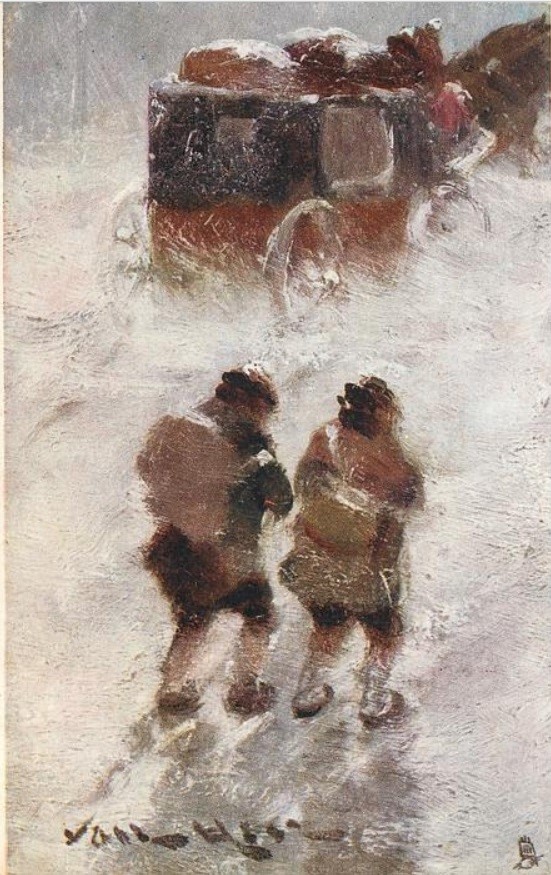
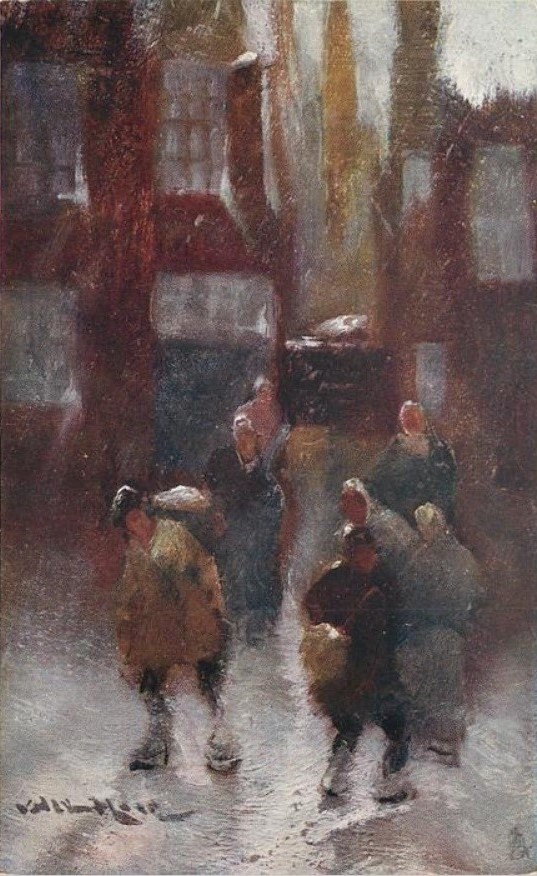
As you examine Snow Drift, you certainly aren’t waiting for a stagecoach to deliver passengers or packages, but the UPS driver may well be on his way or a school bus could be bringing your grandkids home after an early dismissal from school.
A walk just after sundown on A Winter Evening with a group of friends or neighbors may be an invigorating experience but as you finish your conversations and say “good-night” just think how nice the fire in your hearth will feel.
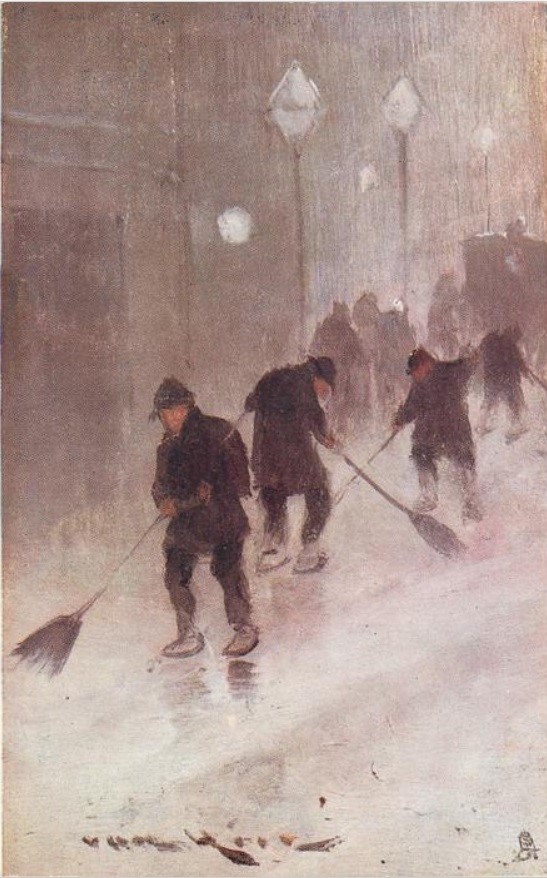
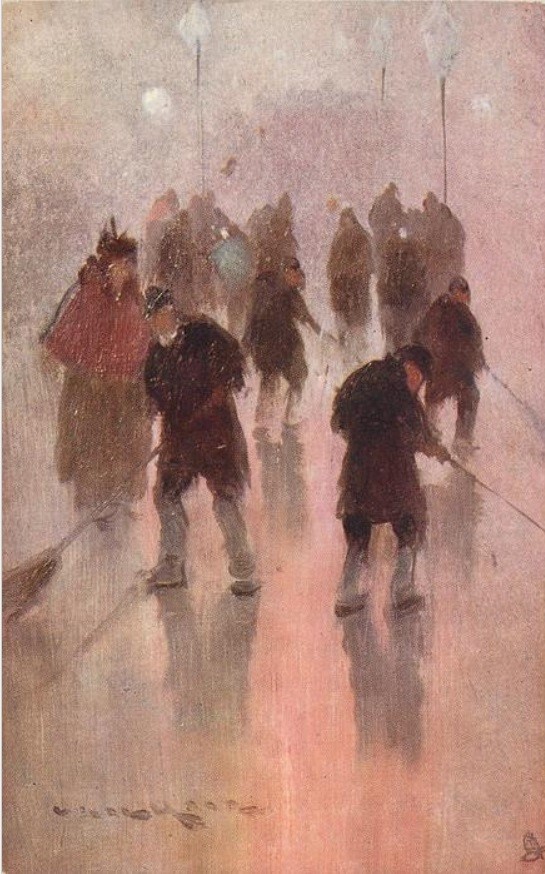
While you visualize how you once spent hours Cleaning the Snow, rejoice in your age and be happy you are old, for the dreadful task of sweeping and shoveling snow has devolved to the young and strong.
The poet once asked, “Oh, what have the heavens brought?” The sun sets with a pink tinge it earned from a successful day, but the rains come and fall upon the ice. Treacherous sidewalks and killer highways make staying home the only option.
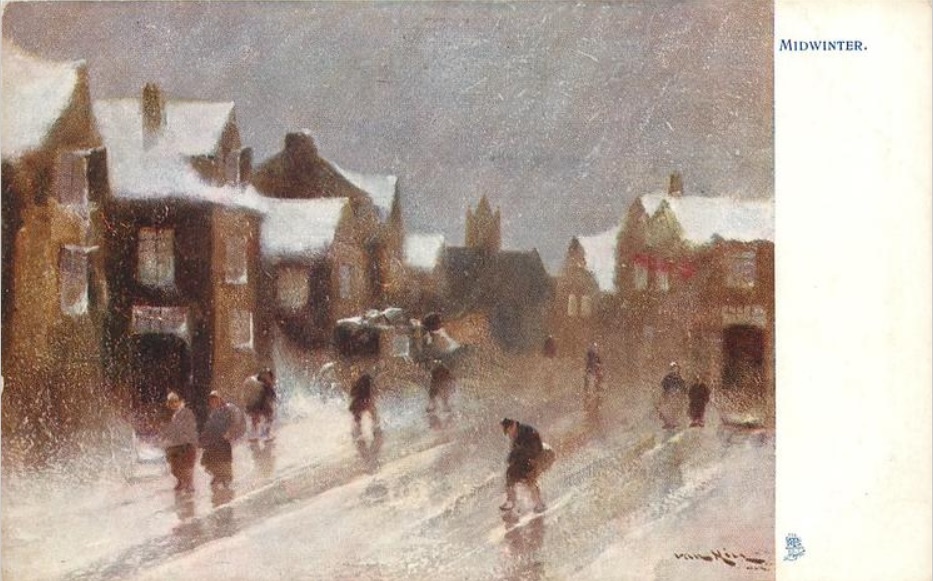
It is Midwinter in your mind, but you will arise in the morning with determination and resolve to power through life’s tasks and chores, even though the calendar says otherwise. You think it is December 22nd (mid-winter’s day) because you are the glee-filled and welcome recipient of a suggestion to “think cool,” but it is really still summertime and you will deal with that reality, too!
***
This featured set is a Tuck’s series entitled, Wonderful White Winter, #7341. The artist, Joachim Hiersch-Minerbi, was born in Austria in 1834. His family immigrated to the United Kingdom while Joachim was still a boy. A career as an artist and teacher was predictable. His work is often maritime in nature or weather related, mostly soft-focus scenes that pry his viewer’s imagination and deeper thought. His artistic influence was wide because of his work for Raphael Tuck; his signature appears on over forty Tuck postcards. He died in London at age 70 in 1905.
The power of suggestion!
I sit here under the HEAT DOME in Texas and read your article. Next thing I know I’ve purchased 6 of Joachim Hiersch-Minerbi’s cards.
Great artist to highlight.
I was born in 1959, live in Indiana, and am glad that I didn’t have to shovel any snow last winter!
Thanks for cooling thoughts on a warm California day. Always find Tuck cards interesting and particularly life of the artists.